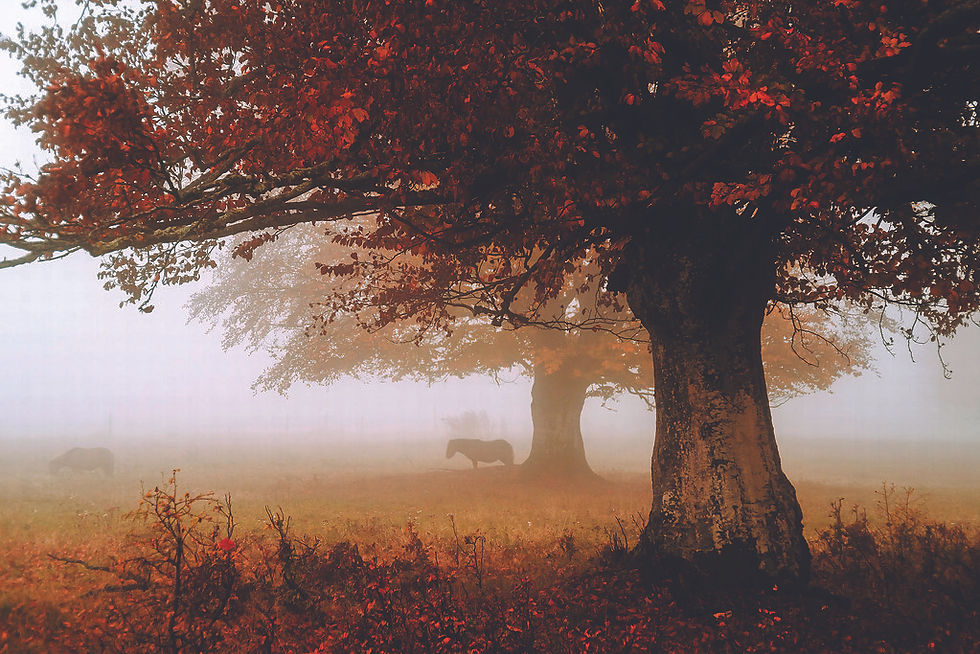The Commemorative dinner in the countryside / Komemorativna večera na selu
- Анђела Петровски
- Feb 6, 2023
- 4 min read
I have traveled a lot throughout the Serbian countryside, but this trip was the first one which was so full of interlaced Christian and Pagan mysticism, ancient Slavic traditions, and the discoveries of antique customs the sense of which I still don’t quite understand. The reason for the trip was sad enough: my friend’s father died a year ago and we were going to the cemetery of his native village in order to organize a commemoration of my friend’s father. That’s why I decided not to take a lot of photo equipment with me besides a simple Yashika and several rolls of film.
Kostunći village, where my friend grew up, is located about 150 km from Belgrade. It is a very picturesque place in a hilly area famous for the Ravna Gora mountain where the Chetniks organize their occasional meetings. The family of Vojislav Koštunica, the last president of Yugoslavia, is also from here. Although many of his relatives are buried here it doesn’t seem that he has ever been to the village. I haven’t managed to find out how old the town is but judging by its tombstones it is very old.
This day was significant for my friend’s family. A lot of relatives and friends came to honor the memory of the dead. Everybody was thoroughly preparing for the commemorative dinner. There was a lot of delicious food: pork roast on a skewer spit, salads, pies, cheese, wine, beer, rakia, coffee, and even one enormous white cake with a lot of creams. They also had to bring a beautiful tablecloth, disposable plates and glasses, serviettes, towels, and the most important thing – the church candles. Everything was loaded into cars and we headed towards the cemetery. Women covered the tomb with a tablecloth.
In the beginning, I felt awkward since we used a tomb as a table, but I was then explained that it was a tradition to share meals with the dead in such a way. The deceased could then see the members of his family gathered around him and share the feast with them. It was my first encounter with such an archaic tradition. I began looking at the tombstones, some of them being more than 200 years old and some of them being put there quite recently, but there was the same surname inscription on each and every one of them. I instantly thought of Gogol’s stories of communicating with the Otherworld and David Lynch’s films where all the events happened in accordance with their own unknown laws.
Photo & Text by Ilmar
Putovao sam puno po Srbiji i obišao mnogo srpskih sela, ali ovo putovanje je prvo koje je bilo toliko ispunjeno isprepletanim hrišćanskim i paganskim misticizmom, starim slovenskim tradicijama i otkrićem antičkih običaja čije značenje i dalje ne mogu u potpunosti da shvatim. Povod za ovo putovanje bio je vrlo tužan: mom prijatelju je umro otac pre godinu dana, te smo zajedno otišli u selo gde je njegov otac rođen kako bismo održali komemoraciju povodom njegove smrti. Baš zbog toga sam odlučio da neću nositi mnogo opreme sa sobom, te samo poneo samo jednu Yashicu i nekoliko filmova.
Selo Koštnići, u kome je moj prijatelj odrastao, udaljeno je oko 150km od Beograda. To je vrlo živopisno mesto na brdovitom području koje je poznato po planini Ravna Gora gde četnici ponekad organizuju svoje sastanke. Porodica poslednjeg predsednika Jugoslavije, Vojislava Koštunice, takođe je poreklom iz ovog sela. Iako je veliki deo njegove rodbine sahranjen ovde, on izgleda nikada nije posetio ovo selo. Nisam uspeo da saznam koliko dugo postoji selo Koštunići, ali sudeći po njegovim nadgrobnim pločama, ono postoji već jako dugo.
Ovaj dan je bio važan za porodicu mog prijatelja. Mnogo rodbine i prijatelja je došlo da oda počast mrtvima. Svi su se dobro pripremili za komemorativnu večeru. Doneli su mnogo ukusnih jela: svinjsko pečenje na ražnju, salate, pite, sireve, vino, pivo, rakiju, kafu i čak jednu ogromnu tortu sa mnogo šlaga. Takođe, morali su i da ponesu prelepi stolnjak, plastične tanjiriće i caše, salvete, peškire, i najvažnije – sveće. Sve je potom spakovano u kola i krenuli smo ka groblju. Kada smo stigli, žene su prekrile grob stoljnjakom.
U početku mi je bilo neprijatno, jer smo koristili nečiji grob kao sto, ali su mi kasnije objasnili da je običaj da se hrana na taj način deli sa onim ko je umro. Pokojnik tako može da vidi članove svoje porodice koji su se okupili zbog njega i da uživa u gozbi sa njima. To je bio moj prvi susret sa tako arhaičnim običajem. Počeo sam da lutam pogledom po ostalim nadgrobnim pločama, od kojih su neke tu preko 200 godina, a neke tek odskora i primetio sam da je na svim nadgrobnim pločama ispisano isto prezime. Odmah sam se setio Gogoljevih priča o razgovorima sa onim svetom i filmova Dejvida Linča u kojima se sve dešava u skladu sa nekim svojstvenim nedokučivim zakonima.
Fotografije & Tekst – Ilmar



























Comments